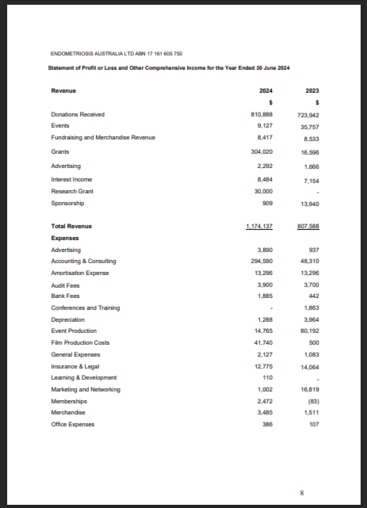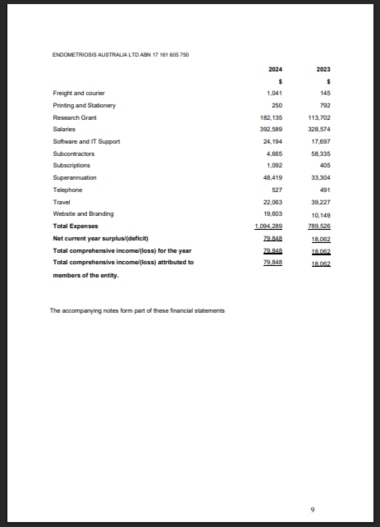Endometriosis Australia spent only $180k on research despite $1.2m in donations, grants
A peak charity spent just over 10 per cent of the more than $1m given in donations and grants on research, spending big on consultants and filming instead.

Business
Don't miss out on the headlines from Business. Followed categories will be added to My News.
Australia’s peak endometriosis charity spent a little more than 10 per cent of the more than $1m they were given in donations and government grants on research, splashing almost $350,000 on consultants and film production instead.
Endometriosis Australia spent about $182,000 on research grants during the 2023-2024 financial year after making more than $800,000 in donations and $300,000 in grants, according to a financial statement published to the government’s charity commission.
The nationally-accredited charity ended the financial year with more than $1.2m in cash after spending almost $300,000 on accounting and consulting, $393,000 on salaries, and $41,000 on “film production costs”, according to the audited report released late last year.
Launched in 2013, Endometriosis Australia’s stated objectives include to raise awareness for the roughly one in seven women in Australia living with endometriosis, as well as to “raise funds for research … into causes, treatments, and ultimately prevention”.
Four projects received funding in 2024, including about $60,000 to a University of Queensland project involving 3D modelling of endometriosis lesions in a lab and almost $50,000 to a University of Technology Sydney study into identifying cancer risks.
University of Sydney Accounting Professor Sandra Van Der Laan said while the charity was offering some explanation of its expenses in its report, “they’re really not explaining the really important things for someone who wants to donate to that charity”.
“I’d be questioning the activities and objectives (of Endometriosis Australia) based on the types of things that I see in their financial statement. Are those things that they’re spending money on furthering the objectives of the charity?” Mr Van Der Laan said.


In respect to the more than $1m in revenue, Ms Van Der Leen pointed to the almost $400,000 spent on salaries in 2023-2024, up about $70,000 in a year, as being “not very attractive”, noting “it doesn’t leave enough money to go towards their charitable purpose”.
The cost of “accounting and consulting” also ballooned from end of financial year 2023 to 2024 – from $48,310 to $294,590 – as did “film production” – from $500 to $41,740 – though so too did the money coming in as revenue from “grants” – $16,596 to $304,020.
Ms Van Der Leen said while she believed there were sufficient regulations around charities, the number of them operating in Australia was of particular concern.
“What it boils down to is there’s so much money spent on administering these things (charities) that the money that people think they’re donating is not really reaching the places that should be reached,” she said.
Endometriosis Australia did not respond to detailed questions about its financial report, including whether donations had been spent appropriately, or how many applications were made for research grants, and if, and on what grounds, any were refused.
The nationally-recognised charity also did not respond to a question on why it was maintaining more than $1.2m in cash reserves.
The questions were sent to the organisation on March 21 with a deadline, the article was published on April 5.
Instead, the body issued a statement declaring it had demonstrated “sector leadership in governance, transparency, and public accessibility of financial information”.
“Our Research Grant Committee works closely with both our Clinical Advisory Committee members and lived experience donors, ensuring funding decisions reflect scientific merit and community needs,” a spokesperson said.
The spokesperson said donations given to the charity in the lead up to “Endo Giving Day” on March 28 contributed to a nursing scholarship program set to have commenced in January 2025, which they said “aligns with our supporters’ priorities”.
Endometriosis Australia was one of three organisations that benefited from a $2.019m pledge by the federal government last year to further women’s health.
In total, Endometriosis Australia was set to receive more than $1m – or about half the announced spending – including $787,000 to develop workplace guidelines to educate organisations on how to support staff living with endometriosis, and “create better awareness”.
The Department of Health and Aged Care did not fund Endometriosis Australia for research work.
The programs commenced in March 2024 and are expected to be completed by mid-2026.
Health Minister Mark Butler was also provided with detailed questions about the Department’s engagement with Endometriosis Australia and whether it thought the funds provided were being spent appropriately, but did not respond before the government entered caretaker mode ahead of the federal election.
Under the same announcement, a further $436,000 was allocated to charity QENDO to support the development of a national endometriosis mentor program, while another $255,000 went to The Australian Coalition for Endometriosis to “drive improvements and support in the endometriosis community”.
According to its own financial statements lodged last year, QENDO ended 2023 with only about $170,000 in assets, including $110,810 in cash, having spent $1672 on “education and endo awareness”.
The financial reports for The Australian Coalition for Endometriosis were not yet available from the regulator and were overdue according to their website. The reporting period for both does not include the funds that would have been received from the 2024 government initiative.
EndoActive founder Lesley Freedman said she was surprised to learn how little Endometriosis Australia had spent on research grants.
“I’m really shocked,” she said.
“It’s a disappointment. A lot of us (endometriosis charities) don’t even have paid people.
“EndoActive has never paid anybody. Its voluntary. We’ve sometimes taken funds out that we’ve needed to buy a new laptop or something.”
Ms Freedman launched the not-for-profit alongside her daughter, Syl, and while she agreed charity staff ought to be paid, charities had to be transparent about where donations were being spent.
“It (the funding) wouldn’t cover very much, that’s for sure,” she said.
“If you’re even paying a researcher – one researcher, for a year – you might get one and a bit for that.
“But, for actual physical research, gosh.”

‘Not enough’: Uproar over endo charity spending
The causes of endometriosis – estimated to impact about 190 million women worldwide – are unknown. Currently there is no cure and no known way of preventing its growth, only sometimes a reduction in symptoms – often with use of a contraceptive device, which can carry risks.
Author and endometriosis advocate Bridget Hustwaite said Endometriosis Australia’s mandatory report made it “difficult for many people with endometriosis to place their trust” in national endometriosis charities, despite an eagerness to do so.
“I fear that these funds are not being spent appropriately, and I know that a large portion of the endometriosis patient community has expressed a desire for more transparency regarding where their donations are actually going,” she said.
Ms Hustwaite said it was “hard to be hopeful when looking to the future for people living with endometriosis”, with a lack of funding towards critical research and training of medical staff, which left the community feeling “neglected and frustrated”.
Melbourne School of Health Sciences Professor and Allied Health Research Lead at the Royal Women’s Hospital, Helena Frawley, said research into endometriosis was critical to improving the health outcomes of people living with the disease, including pain and fertility.
She said treatments that “go beyond surgical and pharmacological treatments of pain”, including those provided by psychologists and dietitians, deserved further research, and that the pelvic pain associated with endometriosis “impacts on their (sufferers) physical, psychological, and social function”.
It’s that impact that University of Canberra associate lecturer Annaleise Naylor hopes to understand.
Ms Naylor is part of a group of researchers currently undertaking a project they hope will be able to paint a clearer picture of what life is like for people living with endometriosis.
As someone living with endometriosis, Ms Naylor said the disease affected how she lived her life, including becoming “withdrawn socially because I didn’t know what that pain was going to look like”.
“The ‘endo fatigue’, that’s probably my biggest symptom, and managing that and being very deliberate and mindful in what I choose to do each and every day,” Ms Naylor said.
Ms Naylor said clinicians also needed to do better in keeping up-to-date on endometriosis research, what the disease looks like, and its “ramifications”.
“It’s not just painful periods, it’s a whole onslaught of symptoms,” she said.
The Albanese government said it would expand its Endometriosis and Pelvic Pain Clinics as part of the 2025-26 federal budget.
The expansion will include funding for 11 new clinics across regional and metropolitan areas, bringing the total number of clinics nationally to 33. The existing 22 clinics, announced as part of the 2023-24 budget, were also set to receive an extension of funding to continue providing specialist care and support.
The clinics are intended to improve the time it takes for many people with endometriosis to receive a diagnosis, with seven currently in NSW, four each in Queensland and Victoria, two in Western Australia, and one each in Tasmania, the Northern Territory and the ACT.
Editor’s Note
In a statement published on April 7, Endometriosis Australia said a “significant portion” of government funding was received in April 2024, explaining the unallocated funds on the ACNC website.
“We are a small charity working diligently to meet stringent governance requirements while delivering crucial programs with limited resources,” Endometriosis Australia chair, Monica Forlano said.
The charity said it received the first year’s tranche $ $465,420 of a three-year government grant totalling $1.328m in mid-April 2024.
Of that. $85,000 for community support, $287,420 for workplace guidelines and education, $93,000 for resources to support Australians with endometriosis.
“Due to payment by Department of Health in mid April these funds hadn’t been acquitted on these specific projects by the end of FY23/24,” the charity.
Endometriosis Australia also said it awarded $270,000 to research, in contradiction to the audited statement quoted in this article.
The statement went on to say that the charity employed five fulltime staff, and that its consultant costs listed in the FY23/24 Financials were for administrative support ($38,000), accounting ($11,000), grant consulting ($25,000), and a national communications agency that supported awareness campaigns to Regional Australia, including creation of a TVC and marketing services ($160,000).
Film production expenses for a 1-hour documentary on fertility cost $41,000.
The details of these expenditures were included in questions put Endometriosis Australia, but were not answered in their reply quoted in this article.
“Endometriosis research remains severely underfunded in Australia. Together, we can make meaningful, lasting change to improve care for Australians living with endometriosis,” Ms Forlano said.
“As the peak body in endometriosis, we advocate for the continuation of the National Action Plan and funding for research and education initiatives.”
Originally published as Endometriosis Australia spent only $180k on research despite $1.2m in donations, grants


